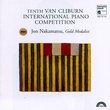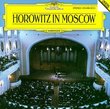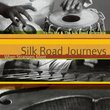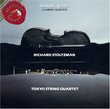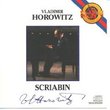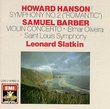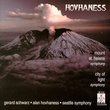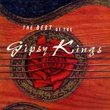| All Artists: Jeno Jando Title: Haydn, Piano Sonatas Vol. 9 Members Wishing: 0 Total Copies: 1 Label: Naxos Release Date: 3/23/1999 Genre: Classical Styles: Chamber Music, Forms & Genres, Fantasies, Sonatas, Historical Periods, Classical (c.1770-1830), Symphonies Number of Discs: 1 SwapaCD Credits: 1 UPC: 730099482622 |
Search - Jeno Jando :: Haydn, Piano Sonatas Vol. 9
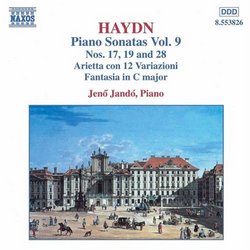 | Jeno Jando Haydn, Piano Sonatas Vol. 9 Genre: Classical
![header=[] body=[This CD is available to be requested as disc only.]](/images/attributes/disc.png?v=15401716) ![header=[] body=[This CD is available to be requested with the disc and back insert.]](/images/attributes/disc_back.png?v=15401716) ![header=[] body=[This CD is available to be requested with the disc and front insert.]](/images/attributes/disc_front.png?v=15401716) ![header=[] body=[This CD is available to be requested with the disc, front and back inserts.]](/images/attributes/disc_front_back.png?v=15401716) |
Larger Image |
CD DetailsSimilarly Requested CDs
|
CD ReviewsExploring the Haydn Sonatas -- Nos. 17, 19, and 28 Robin Friedman | Washington, D.C. United States | 08/08/2009 (4 out of 5 stars) "The Hungarian pianist Jeno Jando has recorded the complete Haydn sonatas, and much else, for the budget-priced Naxos label. I have been listening to each of the ten volumes of Jandos's Haydn and reviewing them here on Amazon to celebrate the Haydn bicentennial (1732 - 1809). Jando's readings of Haydn are deservedly acclaimed.
This CD, the ninth in the original Naxos releases includes three unusual sonatas that, for good reasons, did not find their way into the two-volume Dover set of Haydn's sonatas that I am using as the score during my listening. The three sonatas are oddities but enjoyable. And this CD includes as well a selection of some excellent short piano music of Haydn. Of the sonatas on this CD, the highlight is the three-movement sonata no. 19 in e-minor, which Haydn composed when he was young, as early as 1755. This sonata does not appear in my Dover edition because Haydn used the work as a source for a much later sonata, the sonata no. 47 in F major, which is found in my text. The e minor sonata is a fine work in its own right and appears to be the first Haydn piano sonata in a minor key. The opening adagio is, indeed, poignant and sad, and its minor-key theme is punctuated by the rolling chords that would later become a feature of Haydn's piano style. The second movement is a contrastingly lively and happy allegro replete with long runs over the keyboard. The concluding moderately paced minuet is a graceful movement that relieves the tensions and contrasts of the earlier two parts of the sonata. The three movement sonata no. 17 in E-flat major is not included in my Dover edition because it is probably not by Haydn. This work, which exists only in a manuscript found in a monastery, may well have been composed by an imitator of Haydn or by a monk. The opening movement is a highly-embellished moderato with two appropriately contrasting themes. The minor-key andante is simple and lovely with a singing, sad theme over triplets. Again, the final minuet works to bring the piece to a gracious close. The two-movement sonata no 28 in D major does not appear in my text because it was not discovered until 1961. As recovered, the manuscript of this long-lost work consists of only a portion of an opening movement and a concluding menuet. The brief opening fragment shows that the work was lively and vigorous, characterized by large chords. The minuet which follows also makes great use of the lower part of the instrument's register, with several contrasts between the high and low voices of the keyboard. The short piano pieces add a great deal to this CD. The rarely-heard Arietta with 12 variations, composed around 1765, begins with an engagingly simple two-part theme, both parts of which are repeated. The set of variations is easy to follow and delightful For example, Haydn turns the simple tune into a waltz in one variation, which he follows immediately by giving a march-like character to the tune. After a rousing final variation, the main theme returns without repeats. The remaining notable short work is the Fantasia (Capriccio) in C major composed in 1789, which puts it after the "Paris" symphonies, no. 82-87. The Fantasia is an improvisatory, virtuosic work based largely on a single insistent theme. The piece includes changes in rhythm and tempo, several dramatic pauses, and difficult passages consisting of scales in thirds, large chords, and hand crossings. It was good to get to know this infrequently performed and relatively late piece. The disk also includes the Allegretto in G major and the Adagio in G major, both of which are transcriptions of movements Haydn wrote for other instruments, the Allegretto in G major, which Haydn originally wrote for a mechanical instrument called the flute-clock, and a short adagio in F major. Robin Friedman" |

 Track Listings (14) - Disc #1
Track Listings (14) - Disc #1